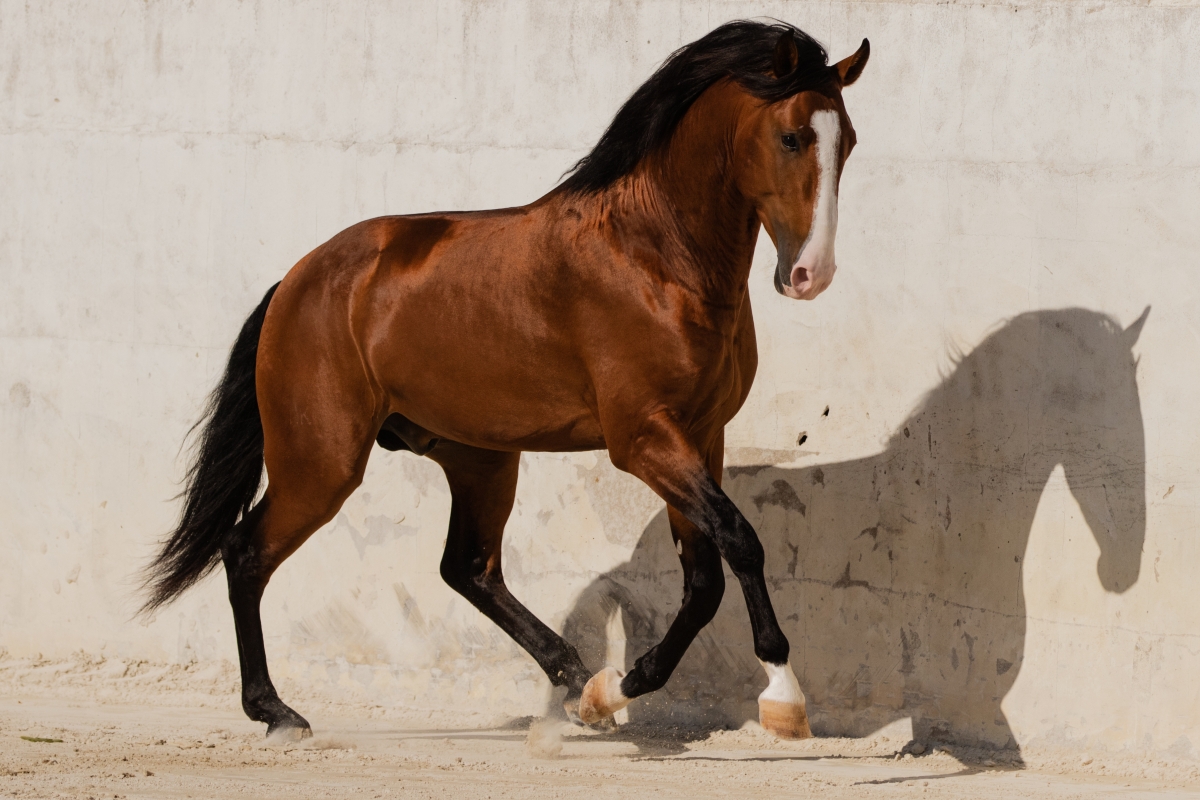Lusitano horses are very similar to Andalusians, however, the main difference is that Lusitano horses have fewer “Arabian” characteristics. Long ago they were used as war horses, years later they started to be seen not only in parades but also in the ring during Portuguese bullfights. Is Altér real breed a different name for Lusitanos? What is the stallion Novilheiro known for? Read our article to find out!

Lusitano horse - history of the breed
Lusitano horse (Pure Blood Lusitano) or in Portuguese - Puro Sangue Lusitano (PSL) originates from the area now known as Portugal – from regions Ribatejo and Alentejo, east of Lisbon. The name of the breed comes from the word “Lusitania”, which was the ancient Roman name for the region of the breed’s origin.
The ancestor of the Lusitano horse, shared with Andalusian horses, is Sorraia. During the Moor invasion of Spain in 711, Iberian horses have been exposed to new genetic pool thanks to mixing with Barb horses from North Africa that was brought by the invaders. In a matter of a century, a common ancestor for Andalusian and Lusitano horses was produced – The Iberian war horse.
In the 16th and 17th centuries, horses traveled between Spain and Portugal frequently and horses bred in Andalusia were constantly mixed with Portuguese cavalry horses. The two main breeding lines of Lusitano included an army one for war purposes and breeding is done by civilians for carriage pulling.
Lusitano horses have been called Andalusian up until 1966 when the name Lusitano was introduced after the separation of the studbook by both countries.
.jpeg)
Uprisings in Portuguese colonies in Africa led to the imminent economic collapse of Portugal. During that time many stables were closed, and horses were sold to Spain. However, the best breeding lines, fortunately, survived thanks to knowledgeable breeders.
These days, Lusitano horses are mainly bred in Portugal and Brazil. It’s a quite popular breed so those horses can be also found in Australia, the USA, North Africa, the UK, and other European countries. Lusitano horses are also bred with Andalusian, Arabian and Thoroughbred horses.
The Portuguese studbook recognizes six horses (five stallions and one mare) as “heads of lineage” These six horses include the founding horses from the main breeding lines: Andrade, Veiga, and Coudelaria Nacional. Even though each line meets the criteria of the Lusitano breed and has minimal differences, they still have individual characteristics that are specific to each line.
Those six founding horses are:
- Agareno, stallion Veiga from the year 1931, out of Bagocha, by Lidador
- Primorosa, stallion Dominquez Hermanos from the year 1927, out of Primorosa II, by Presumido
- Destinado, stallion Dominquez Hermanos from the year 1930, out of Destinady, by Alegre II
- Marialva II, stallion Antonio Fontes Pereira de Melo from the year 1930, out of Campina, by Marialva
- Regedor, stallion Alter Real from the year 1923, out of Gaviny, by Gavioto
- Hucharia, mare Coudelaria Nacional from the year 1943, out of Viscaina, by Cartujano
.jpeg)
Lusitano horses and Altér Real
Altér Real is one of the breeding lines of Lusitano horses. They are bred only in the Altér Real stable (Altér de Chao) in Alentejo, Portugal. The stable has been founded in 1748 by the Portuguese royal family to supply the national equestrian academy and royal court with parade horses. These days the Portuguese School of Equestrian Arts (Escola Portuguesa de Arte Equestre) solely uses Lusitano horses in their performances.
Altér Real breeding line was created from 300 Iberian mares that were brought from Spain in 1747. When Napoleon invaded Spain at the beginning of the 19th century, the Altér Real lineage worsened due to mixes with Arabian, Thoroughbreds, and Hanoverian horses. However, in the 19th and 20th centuries, the lineage was preserved thanks to regular mixes with Iberian horses.
At the beginning of the 20th century along with the Portuguese Revolution in 1910 which ended the monarchy, almost wiped out the Altér Real breeding line as well. Royal studs were closed, and archives were destroyed. The line survived only thanks to Ruy d'Andrade, a Portuguese hippologist who specialized in Iberian horses, who saved two stallions and a few mares. In 1942 he gifted his herd to the Portuguese Ministry of Agriculture when the state stud farm was reopened. The Portuguese authorities kept the state Altér Real stud and still breeds horses for the Portuguese School of Equestrian Arts.
What’s interesting is that Altér Real horses can only be bay. Altér Real horses differ from Lusitanos in characteristics – they have a more straight face line (similar to Andalusian horses), they have less prominent withers, and often sloping shoulders.
.jpeg)
Lusitano horses - characteristics and appearance
Lusitano horses resemble Andalusians, however, they have fewer characteristics of Arabian horses. This is reflected in their convex head profile as well as more sloped croup and lower-set tail.
They have a swan neck that is highly set, just like other Iberian horses. Lusitano horses have short backs, well-defined shoulders, and a muscular, sloping croup, which allows them to easily put their body weight on hind legs (which is required in higher levels of dressage). Their extravagant gait is due to their slim and long legs, as well as sturdy hoofs and pasterns. Both Lusitano and Andalusian horses have eye-catching long, thick manes and tails.
Height: 150-160cm
Weight: around 500kg
Coat colors: all the basic coat colors, mainly: grey, bay and buckskin
.jpeg)
Lusitano - usage
Lusitano horses were first bred to be war horses and pull carriages but today they’re great as dressage or recreational horses.
In Portugal, they are still used as working horses on farms and as bullfighting horses. Modern bullfights are less brutal, the bulls are not killed, and riders are blamed for any injuries to horses. Bullfighting Lusitanos are agile, and calm and stay under complete control of the rider during a confrontation with a bull.
What’s interesting, Lusitano horses can be great jumpers too. Stallion Novilheiro with a famous British rider John Whitaker won Great Britain’s National Championship and later was a leader in the European cash prize ranking.
Other successes of this breed include:
- In 1995 a team of four horses driven by a Belgian driver Felix Brasseur won FEI World Cup in combined driving and World Championship in 1996.
- The Portuguese dressage team that rode Lusitano horses won a bronze team medal during the World Equestrian Games in 2002 and a silver medal during Summer Olympic Games in 2004.
- During the World Equestrian Games in 2002, there was a Lusitano horse that helped a team win a bronze team medal in dressage and a silver medal during the Summer Olympic Games in 2004.
- In 2006 during the World Equestrian Games, a Portuguese dressage team rode Lusitano horses (just like one of the Spanish dressage riders), and the mentioned above Belgian driver Felix Brasseur won a gold medal in combined driving with a team of four Lusitano horses.
.jpeg)
Lusitano horses - price
Prices of Lusitano horses start from 35 thousand PLN and go up to 250 thousand PLN or sometimes even more. The price depends on the horse's pedigree, age, level of training and achievements.
Summary
Lusitano horses right next to Andalusian horses became the main horse breeds used in shows, parades, and other performances.They are also prominent in high school dressage. Their natural tendency to put weight on their hind legs and elevated movement made them perfect horses for spectacular bullfights. For many, it’s also a perfect dressage horse that can achieve high levels of training in this discipline.




.jpeg)

.jpeg)
.jpeg)
.jpeg)
.jpeg)




